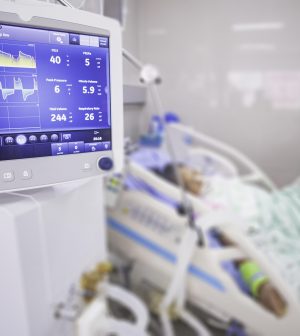- Navigating Your Midlife Crisis: Embracing New Possibilities
- City Raccoons Showing Signs of Domestication
- Mapping the Exposome: Science Broadens Focus to Environmental Disease Triggers
- One Week Less on Social Media Linked to Better Mental Health
- Your Brain Changes in Stages as You Age, Study Finds
- Some Suicide Victims Show No Typical Warning Signs, Study Finds
- ByHeart Formula Faces Lawsuits After Babies Sickened With Botulism
- Switch to Vegan Diet Could Cut Your Greenhouse Gas Emissions in Half
- Regular Bedtime Does Wonders for Blood Pressure
- Dining Alone Could Mean Worse Nutrition for Seniors
Heavy Sedation Could Drive Hispanic Patients’ Higher Death Rate While on Ventilators

Hispanic Americans who are hospitalized and placed on ventilators have a higher risk of death than their white peers, and new research may reveal a reason why.
The study found that Hispanic patients in respiratory failure receive heavy sedation at a rate that is five times that of white patients, according to researchers at New York University (NYU).
That could lower their odds for survival, said a team led by NYU’s Mari Armstrong-Hough, an assistant professor of social and behavioral sciences and epidemiology at the NYU School of Global Public Health.
“Hispanic patients spend more time deeply sedated than non-Hispanic patients. Deep sedation is a known risk factor for death as well as a host of other major long-term problems,” she explained in a university news release. “This is an especially important finding because oversedation is modifiable– in other words, we can do something about it.”
Along with colleagues at the University of Michigan, the NYU researchers tracked data from a clinical trial underway at 48 U.S. hospitals.
The study included 505 patients stricken with acute respiratory distress syndrome (ARDS). ARDS involves a dangerous buildup of fluid in the lungs, impairing breathing and low blood oxygen levels.
ARDS can develop as a consequences of severe COVID-19 or sepsis. Typical care involves sedation and placement on a ventilator.
Looking at the study data, Armstrong-Hough’s group found that over 90% of the patients did receive heavy sedation at some point during their first five days on the ventilator. Overall, patients spent an average of 75% of those five days deeply sedated.
After accounting for a number of possible confounding factors, the researchers found that Hispanic patients experienced that intensity of sedation at five times the rate of white patients.
The findings were published recently in the Annals of the American Thoracic Society.
It’s not yet clear why Hispanic patients are heavily sedated more often, although the team speculate that language barriers and cultural differences between patients, their families and hospital staff might be a factor.
Other factors might be differences in the quality of hospitals that serve a Hispanic clientele, or what the researchers call “implicit bias” on the part of doctors.
Whatever the cause, “there is a need to broadly assess how care is delivered to Hispanic patients, examine why differences in care exist, and develop interventions that provide resources to ICUs to eliminate disparities that may result in worse outcomes,” said study co-principal investigator Thomas Valley, an associate professor of pulmonary and critical care medicine at the University of Michigan.
“Given the widespread use of deep sedation we found in the study, this is an opportunity to improve sedation for everyone, but there is clearly a greater need to improve sedation for Hispanic patients because of what we know about disparities in their outcomes,” he said.
More information
Find out more about ARDS at the Mayo Clinic.
SOURCE: New York University, news release, Feb. 16, 2024
What This Means for You:
Hispanic patients receive deep sedation at higher rates while on respirators, and that could be dangerous.
Source: HealthDay
Copyright © 2025 HealthDay. All rights reserved.










